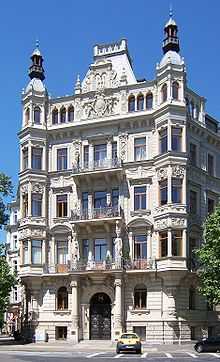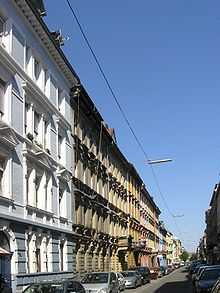Gründerzeit

Gründerzeit (German pronunciation: [ˈɡʁʏndɐˌtsaɪt], literally: "the Founder Epoch"), also referred to as promoterism, was the economic phase in 19th century Germany and Austria before the great stock market crash of 1873. At this time in Central Europe the age of industrialisation was taking place, whose beginnings were found in the 1840s. No precise time for this phase can be given, but in Austria the March Revolution of 1848 is generally accepted as the beginning for economic changes, in contrast to political reforms. In Germany, as a consequence of the large influx of capital resulting from French war reparations from the Franco-Prussian War of 1870–1871, and the subsequent German Unification, there followed an economic boom, giving rise to the description of these years as the "founding years."
These years in Central Europe were a time that citizens increasingly influenced cultural development. This was also the epoch of classical liberalism, even if the political demands of the time were only partially met, and then only in the later period. Industrialisation also posed aesthetic challenges, above all in the fields of architecture and craftsmanship, through development of existing forms, rather than innovation as such.
In common parlance the term Gründerzeitstil is often mingled with Historicism, which was the predominant architectural style after 1850 until 1914, leading to a blurring of the terms. In historical context different decades are often also called Gründerzeit. For this reason, the term Gründerzeit is used to refer to several periods; for example 1850-1873, 1871–1890, sometimes 1850–1914 for the architecture, or even just the years 1871–1873.
Economy
The German term Gründerzeit refers to the great economic upswing in the mid-19th century, when the founders of business (entrepreneurs, Gründer) could apparently become rich overnight. Of particular importance for speedy economic development was the rise of a developed railway system. Not only was it a major factor in its own right on the business scene of the time, but it also permitted further development through improved communication and migration. Rural migration to the cities assisted the development of a proletariat, with an attendant increase in social problems.
The huge stock market crash of 1873, combined with economic overheating due to enormous French reparations from the war, put an abrupt end to this upswing, referred to in German as the Founding Epoch Crisis (Gründerkrise), resulting in a twenty-year phase of economic stagnation. This crisis caused the theory of economic liberalism to lose ground, and it was also this time which saw the introduction of business control mechanisms, as well as protective customs tariffs.
The Vienna stock market crash led to the panic of 1873 in the United States, resulting in the Long Depression.

Design and architecture
The need for housing rose in consequence of industrialisation. Complete housing developments in the so-called Founding Epoch Architecture style arose in previously green fields, and even today in Central European cities large numbers of buildings from this time can be found together along one single road or even in complete districts. These 4- to 6-story buildings, often constructed by private property developers, often sported richly decorated façades in the form of Historicism such as Gothic Revival, Renaissance Revival, German Renaissance and Baroque Revival. The span of construction served not only for magnificent palaces for nouveau-riche citizens, but also the construction of infamous rental ghettos for the expanding urban lower classes.
This phase was important also for the integration of new technologies in architecture and design. A determining factor was the development of new processes in producing steel (Bessemer process) which made possible the construction of steel façades. A classical example of this new form is found in the steel and glass construction of the Crystal Palace, completed in 1851, revolutionary for the time and an inspiration for future decades.
Gründerzeit in Austria
In Austria the Gründerzeit began after 1840 with the industrialisation of Vienna, as well as the regions of Bohemia and Moravia. Liberalism reached its zenith in Austria in 1867 during the Austro-Hungarian monarchy and remained dominant until the mid-1870s.
Vienna, the capital and residence of Emperor Franz Joseph, after the failed uprising of 1848, became the fourth largest city in the world with the inclusion of suburbs and an influx of new residents from regions of Austria. In the place where the city wall had once stood, a ring road was built, and ambitious civic buildings—including the Opera House, Town Hall, and Parliament—were constructed. In contrast to agricultural workers and urban labourers, an increasingly wealthy upper-middle class built itself monuments and mansions. This occurred on a smaller scale in cities such as Graz, but on the periphery, thereby preserving the old city from destructive redevelopment.
Gründerzeit in Germany
In the mindset of many Germans, the epoch is intrinsically linked with Kaiser Wilhelm I and Chancellor Bismarck, but it did not end with them (in 1888/1890) but continued well into the reign of Kaiser Wilhelm II. It was a Golden Age for Germany, when the disasters of the Thirty Years' War and the Napoleonic Wars were remedied, and the country competed internationally on a world-class level in the domains of science, technology, industry and commerce. This was the time when particularly the German middle class rapidly increased their standard of living, buying modern furniture, kitchen fittings and household machines.
The social effects of Industrialization were the same as in other European nations: Increased agricultural efficiency and introduction of new agricultural machines led to a polarized distribution of income in the countryside. The landowners won out to the disadvantage of the agrarian unpropertied workforce. Emigration, most of all to America, and urbanization were a consequence.

In the rapidly growing industrial cities, new workers' dwellings were erected, lacking in comfort by today's standards but also criticized as unhealthy by physicians of the time: "without light, air and sun", quite contrary to the then prevailing ideas on town planning. The dark, cramped flats took a large part of the blame for the marked increase in tuberculosis, that spread also to wealthier neighborhoods.
However, the working class too saw improvements of living standards and other conditions, for instance social security through laws on workers' health insurance and accident insurance introduced by Bismarck in 1883/1884, and in the long run also through the foundation of a Social Democracy that would remain the model for the European sister parties until Hitler's Machtübernahme in 1933. Even today the model of social care developed by Bismarck in 1873 (Reichsversicherungsordnung) remains the contractual basis for health insurance in Germany.
Further reading
- Baltzer, Markus (2007). Der Berliner Kapitalmarkt nach der Reichsgründung 1871: Gründerzeit, internationale Finanzmarktintegration und der Einfluss der Makroökonomie. Münster: LIT. ISBN 9783825899134. (German)
- Hermand, Jost (1977). "Grandeur, High Life und innerer Adel: ‘Gründerzeit’ im europäischen Kontext". Monatshefte 69 (2): 189–206. JSTOR 30156817. (German)
External links
![]() Media related to Gründerzeit architecture in Germany at Wikimedia Commons
Media related to Gründerzeit architecture in Germany at Wikimedia Commons
| |||||||||||||||||||||||||||||||||||||||||
